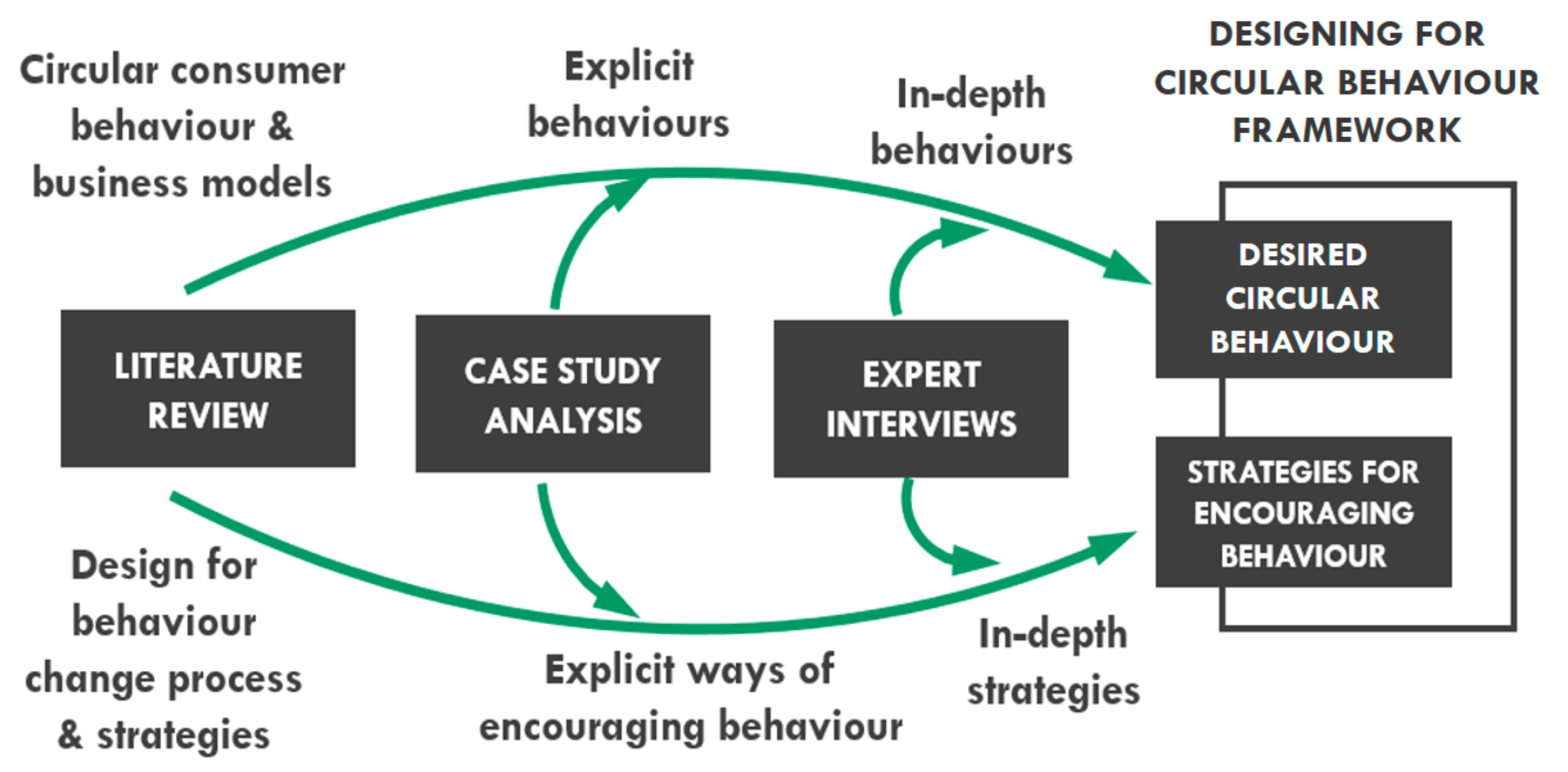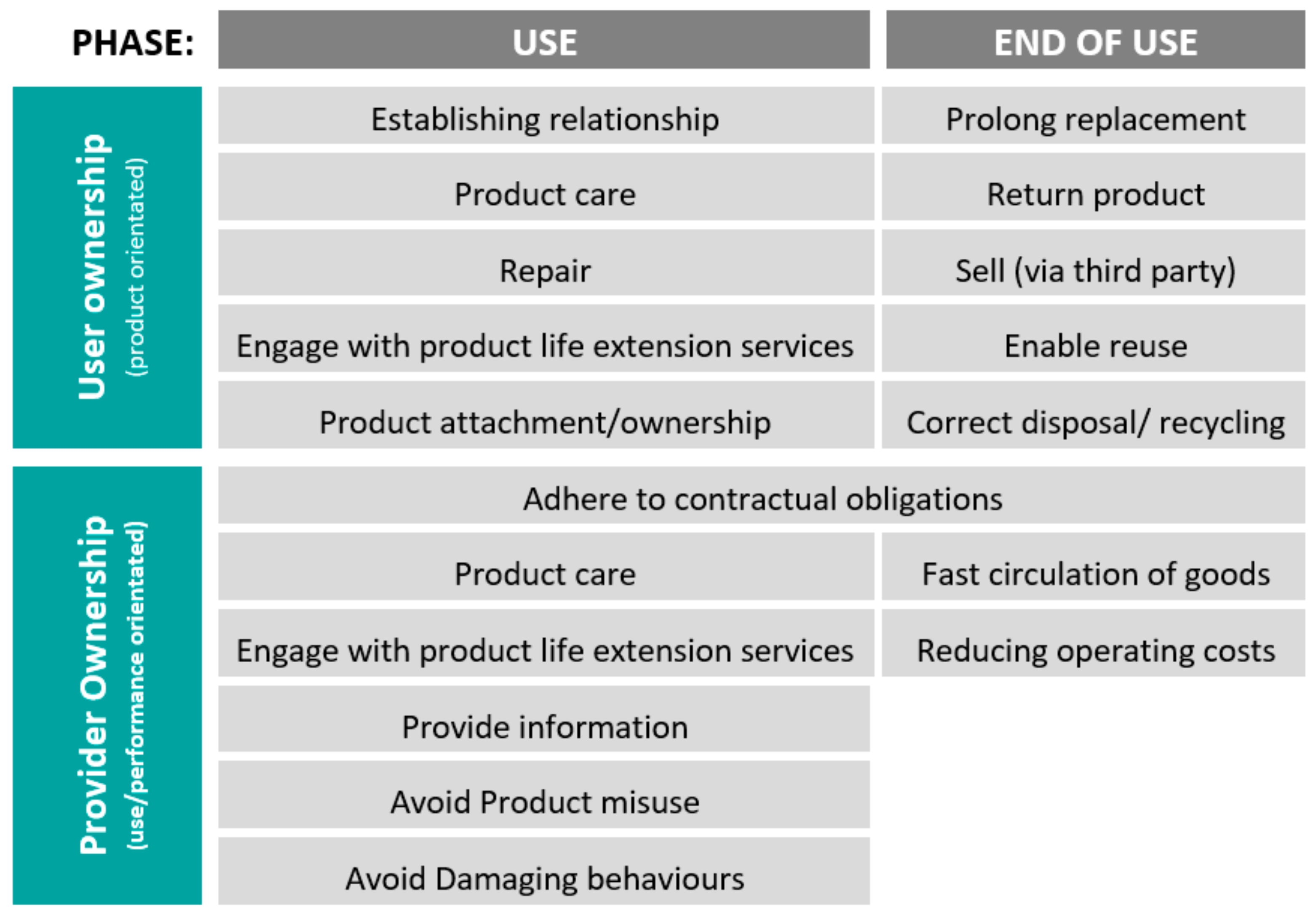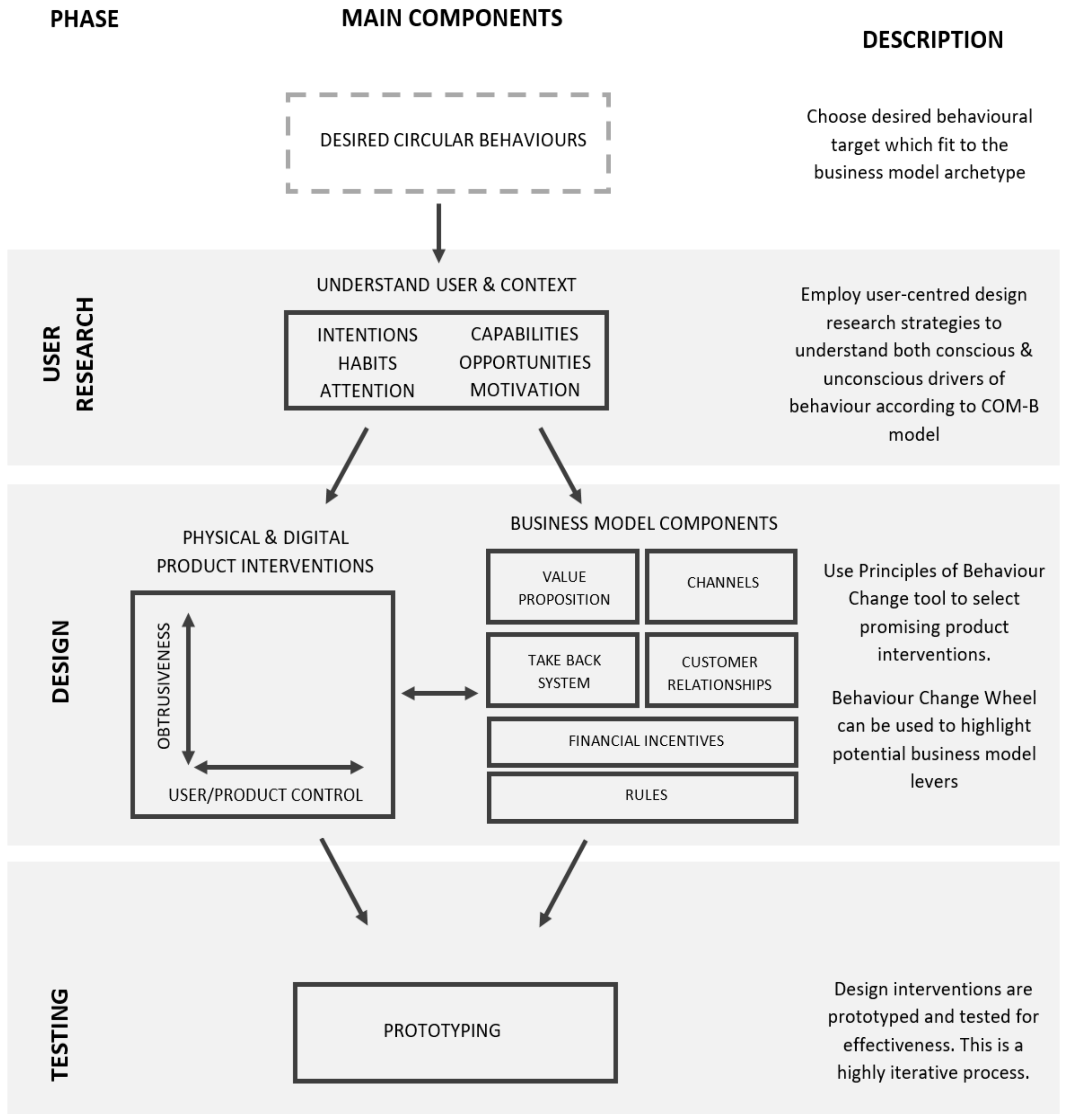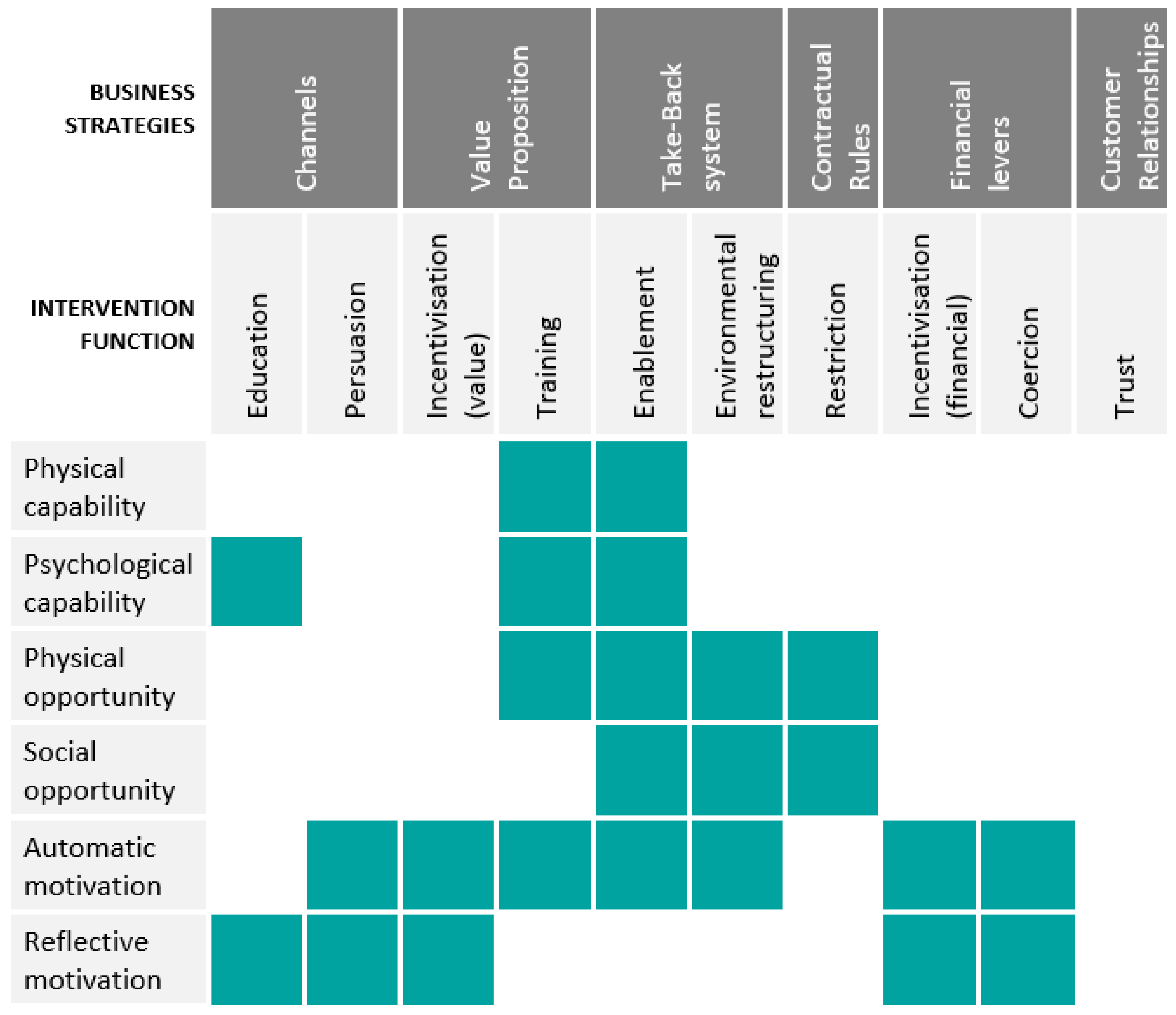Design for Circular Behaviour: Considering Users in a Circular Economy
Abstract
1. Introduction
- to define exactly what user behaviour, if any, is required to enable a transition to a more circular economy;
- to create a framework for designing products and services to encourage desired circular behaviours.
2. Background Research
2.1. Design for a Circular Economy
2.2. Design for Behaviour Change
2.3. Phases of Influence
3. Methods and Concept of the Study
Stage 1: Literature review
Stage 2: Case study analysis
- product-orientated: profit based on selling products, but with supporting services. Similar to the ‘Classic long life model’ outlined by Bakker et al. [22].
- use-orientated: the actual product still plays a key role to the value proposition, except ownership is with the service provider. Also known as ‘The Access Model’ [22].
- results-orientated: the value proposition is based on an actual result or required task, not on a specific product.
Stage 3: Expert Interviews
Stage 4: Synthesis and interpretation
4. Findings: Literature Review
- Making a desired behaviour easier for a user to do,
- Making an undesired behaviour harder to do,
- Trying to get users to want to perform a particular behaviour,
- Trying to decrease user’s inclination to perform a particular behaviour.
4.1. Physical and Digital Product Strategies
4.2. Wider Business Strategies
5. Findings: Case Studies and Practitioner Interviews
5.1. Desired Circular Behaviour
5.2. Strategies for Encouraging Behaviour
6. Synthesis and Interpretation
6.1. Desired Circular Behaviours
6.1.1. User Ownership of Products
During Use
End of Use
6.1.2. Provider Ownership
During Use
End of Use
6.2. Business Strategies for Encouraging Behaviour
7. Designing for Circular Behaviour (DfCB)
7.1. User Research
7.2. Design
7.3. Testing
8. Discussion
- There is a risk of failing to achieve the intended behaviour change by focusing on specific use scenarios.
- There is a risk of missing opportunities of larger scales of change by focusing too much on the scale of the individual level.
9. Conclusions
Author Contributions
Acknowledgments
Conflicts of Interest
Appendix A
| Code | Case Study Example/Interview Quote | |
|---|---|---|
| Product-based business models | Use repair service | ‘just keep tapping in to the (service) network, keep using it, the product and the service’ |
| Self-repair | Patagonia encourages and enables customers to make repairs to their clothing [72]. | |
| Product care | ‘They may need to do maintaining behaviours, such as cleaning the hair, or descaling it. Keep products up and running in their top form. Small day to day things that users can do to stop issues from happening.’ | |
| Enable reuse | The Optimist toaster concept from The Agency of Design is designed to be passed down through the generations [87] | |
| Sell | ‘we encourage the Ebay market—we absolutely encourage that market’ | |
| Send back to manufacturer | With IDEO’s Optimax concept, the user returns the whole trainer after use [71]. | |
| Send parts back | ‘if we are predicting that a product has particular issues, or needs a tweaking or parts swap, it’s great if they comply and play a restorative role’ | |
| Not disposing of products | ‘sadly with a lot of these products, they will just go in the bin because it’s the easiest option’ | |
| Prolonging disposal | Vitsoe aims to avoid the customer cycle of replacement and repurchasing through offering product-life prolonging services at nominal cost [44] | |
| Suitable recycling | ‘for recycling—having the user do more suitable end of life things like disassembling, separating materials- that could also be a desirable user behaviour’ | |
| Establishing relationship | ‘establishing a relationship between the customer and the manufacturer, and understanding why that might bring value for them’ | |
| Increase use phase | ‘we need to slow the consumption down, that’s one of the problems for the circular economy—there’s so much volume’ | |
| Not forgetting products | ‘products that customers already own might have low worth in their mind and that’s a challenge. Unused products are very back of mind.’ | |
| Access/performance based model | Communal care | ‘being a good user for the next person’ |
| Product specific care | Toronto Tool Library asks service users not to overcharge the batteries of their tools [68]. | |
| Return in good condition | ‘you could ask them to get involved to make all of our end of life processes easier—to have less cost associated with acquiring the inputs for a second cycle’ | |
| Reducing operational cost | ‘The last mile is expensive. Being prepared to pick up stuff and return stuff to a local pick up point’ | |
| Keep product for long time | Bundles uses a deposit mechanism to encourage customers to keep product for a long time. | |
| Not forgetting about product | ‘worth of products that customers already own have low worth in their mind and that’s a challenge. Unused products are very back of mind.’ | |
| Swapping broken parts | Gerrard Street requires users to return parts of the headphones which break [88] | |
| Non-damaging behaviours | ‘Not break products—not doing destructive behaviours’ | |
| Product misuse | ‘We need them to use it in the intended way—for example, using beard trimmer for shaving their cat. This type of behaviour can break a product and can be unhygienic’ | |
| Contractual obligations | ‘financial behaviours for monthly paying, not defaulting on a payment’ |
Appendix B
| Code (Intervention Function) | Case Study Example/Interview Quote |
|---|---|
| Incentivisation (financial) | ‘help them pass it onto a good cause and maybe get a bit of income from it’ |
| Incentivisation (providing value) | ‘a circular model can help meet that need (of closure) if you’re handing something back, you have that closure’ ‘with the shoe, the value was data, so there is an incentive for you to return it’ |
| Training | Patagonia is partnered with iFixit to explain to users how to repair their garments (iFixit 2017) |
| Education | ‘education, education, education… that’s what we are doing, day in, day out’ |
| Persuasion | ‘Persuading them that spending a little more on day one will actually cost them less in the long run’ |
| Enablement | ‘making it as convenient as possible’ ‘customers want the most convenient way to get things out of their house’ |
| Environmental restructuring | Mud Jeans provides a repack and return to label to send them old jean after buying new ones (MUD Jeans 2017) |
| Trust | ‘need to try get trust and an attachment to a service’ |
References
- Ellen MacArthur Foundation. Growth within: A Circular Economy Vision for a Competitive Europe; Ellen MacArthur Foundation: Cowes, UK, 2015; p. 100. [Google Scholar]
- Blomsma, F.; Brenna, G. The Emergence of Circular Economy. J. Ind. Ecol. 2017, 21, 603–614. [Google Scholar] [CrossRef]
- Prendeville, S.; Bocken, N. Design for Remanufacturing and Circular Business Models. Sustain. Innov. Prod. Life Cycle Des. 2017, 269–283. [Google Scholar]
- Webster, K. The Circular Economy: A Wealth of Flows, 2nd ed.; Ellen MacArthur Foundation Publishing: Cowes, UK, 2017. [Google Scholar]
- Ellen MacArthur Foundation. Towards the Circular Economy Volume 1: Economic and Business Rationale for an Accelerated Transition; Ellen MacArthur Foundation: Cowes, UK, 2012. [Google Scholar]
- Moreno, M.; Braithwaite, N.; Cooper, T. Moving beyond the circular economy. In Proceedings of the Going Green–CARE Innovation, Vienna, Austria, 17–20 November 2014; pp. 1–10. [Google Scholar]
- Ellen MacArthur Foundation. Towards a Circular Economy: Business Rationale for an Accelerated Transition; Ellen MacArthur Foundation: Cowes, UK, 2015. [Google Scholar]
- Park, J.; Sarkis, J.; Wu, Z. Creating integrated business and environmental value within the context of China’s circular economy and ecological modernization. J. Clean. Prod. 2010, 18, 1494–1501. [Google Scholar] [CrossRef]
- Lewandowski, M. Designing the business models for circular economy-towards the conceptual framework. Sustainability 2016, 8, 1–28. [Google Scholar] [CrossRef]
- Bocken, N.M.P.; de Pauw, I.; Bakker, C.; van der Grinten, B. Product design and business model strategies for a circular economy. J. Ind. Prod. Eng. 2016, 33, 308–320. [Google Scholar] [CrossRef]
- Circular Advantage: Innovative Business Models and Technologies to Create Value in a World without Limits to Growth. Available online: https://www.accenture.com/t20150523T053139__w__/us-en/_acnmedia/Accenture/Conversion-Assets/DotCom/Documents/Global/PDF/Strategy_6/Accenture-Circular-Advantage-Innovative-Business-Models-Technologies-Value-Growth.pdf (accessed on 24 May 2018).
- Tukker, A. Product services for a resource-efficient and circular economy—A review. J. Clean. Prod. 2015, 97, 76–91. [Google Scholar] [CrossRef]
- Stahel, W.R. The Performance Economy; Palgrave Macmillan: Hampshire, UK, 2010. [Google Scholar]
- Stahel, W.R. The Utilization-Focused Service Economy: Resource Efficiency and Product-Life Extension. In The Greening of Industrial Ecosystems; National Academy Press: Washington, DC, USA, 1994; pp. 178–190. [Google Scholar]
- McDonough, W.; Braungart, M. Cradle to Cradle: Remaking the Way We Make Things; North Point Press: New York, NY, USA, 2002. [Google Scholar]
- Cox, J.; Griffith, S.; Giorgi, S.; King, G. Consumer understanding of product lifetimes. Resour. Conserv. Recycl. 2013, 79, 21–29. [Google Scholar] [CrossRef]
- den Hollander, M.C.; Bakker, C.A.; Hultink, E.J. Product Design in a Circular Economy: Development of a Typology of Key Concepts and Terms. J. Ind. Ecol. 2017, 21, 517–525. [Google Scholar] [CrossRef]
- Van den Berg, M.R.; Bakker, C.A. A product design framework for a circular economy. In Proceedings of the PLATE Conference, Nottingham, UK, 17–19 June 2015; pp. 365–379. [Google Scholar]
- Mugge, R.; Schoormans, J.P.L.; Schifferstein, H.N.J. Design Strategies to Postpone Consumers’ Product Replacement: The Value of a Strong Person-Product Relationship. Des. J. 2005, 8, 38–49. [Google Scholar] [CrossRef]
- Wilson, G.T.; Smalley, G.; Suckling, J.R.; Lilley, D.; Lee, J.; Mawle, R. The hibernating mobile phone: Dead storage as a barrier to efficient electronic waste recovery. Waste Manag. 2017, 60, 521–533. [Google Scholar] [CrossRef] [PubMed]
- The Waste and Resources Action Programme (WRAP). Switched on to Value: Powering Business Change; WRAP: Oxford, UK, 2017. [Google Scholar]
- Bakker, C.; den Hollander, M.; van Hinte, E.; Zijlstra, Y. Products That Last: Product Design for Circular Business Models; TU Delft Library: Delft, The Netherlands, 2014. [Google Scholar]
- Andrews, D. The circular economy, design thinking and education for sustainability. Local Econ. 2015, 30, 305–315. [Google Scholar] [CrossRef]
- De los Rios, I.C.; Charnley, F. Skills and Capabilities for a Sustainable and Circular Economy. J. Clean. Prod. 2017, 160, 109–122. [Google Scholar] [CrossRef]
- Piscicelli, L.; Ludden, G.D.S. The potential of Design for Behaviour Change to foster the transition to a circular economy. In Proceedings of the DRS 2016, Design Research Society 50th Anniversary Conference, Brighton, UK, 27–30 June 2016; pp. 1–16. [Google Scholar]
- Ellen MacArthur Foundation. Towards the Circular Economy Volume 2: Opportunities for the Consumer Goods Sector; Ellen MacArthur Foundation: Cowes, UK, 2013. [Google Scholar]
- RSA Action and Research Center. Designing for a Circular Economy: Lessons from the Great Recovery 2012–2016; RSA Action and Research Center: London, UK, 2016. [Google Scholar]
- Moreno, M.; de los Rios, C.; Charnley, F. Guidelines for Circular Design: A Conceptual Framework. Sustainability 2016, 8, 937. [Google Scholar] [CrossRef]
- Design Council. The Design Economy: The Value of Design to the UK; Design Council: London, UK, 2015. [Google Scholar]
- Ellen MacArthur Foundation and IDEO, The Circular Design Guide. 2016. Available online: https://www.circulardesignguide.com/ (accessed on 15 June 2017).
- Tang, T.; Bhamra, T.A. Changing Energy Consumption Behaviour through Sustainable Product Design. In Proceedings of the DESIGN 2008, the 10th International Design Conference, Dubrovnik, Croatia, 19–22 May 2008; pp. 1359–1366. [Google Scholar]
- Wilson, G.T.; Bhamra, T.; Lilley, D. Reducing domestic energy consumption: A user-centred design approach. In Proceedings of the Knowledge Collaboration & Learning for Sustainable Innovation ERSCP-EMSU Conference, Delft, The Netherlands, 25–29 October 2010; pp. 200–222. [Google Scholar]
- Wever, R.; van Kuijk, J.; Boks, C. User-centred design for sustainable behaviour. Int. J. Sustain. Eng. 2008, 1, 9–20. [Google Scholar] [CrossRef]
- Norman, D.A. The Psychology of Everyday Things; Basic Books: New York, NY, USA, 1988. [Google Scholar]
- Lockton, D.; Harrison, D.; Stanton, N.A. The Design with Intent Method: A design tool for influencing user behaviour. Appl. Ergon. 2010, 41, 382–392. [Google Scholar] [CrossRef] [PubMed]
- Bhamra, T.; Lilley, D.; Tang, T. Design for Sustainable Behaviour: Using Products to Change Consumer Behaviour. Des. J. 2011, 14, 427–445. [Google Scholar] [CrossRef]
- Ceschin, F.; Gaziulusoy, I. Evolution of design for sustainability: From product design to design for system innovations and transitions. Des. Stud. 2016, 47, 118–163. [Google Scholar] [CrossRef]
- Selvefors, A.; Strömberg, H.; Renström, S. What a designer can change: A proposal for a categorisation of artefact-related aspects. In Proceedings of the 2016 Design Research Society 50th Anniversary Conferance, Brighton, UK, 27–30 June 2016; pp. 1–17. [Google Scholar]
- Baxter, W.; Childs, P. Designing Circular Possessions. In Routledge Handbook of Sustainable Product Design; Chapman, J., Ed.; Routledge: Abingdon, UK, 2017; pp. 391–404. [Google Scholar]
- Antikainen, M. Towards Circular Economy Business Models: Consumer Acceptance of Novel Services. In Proceedings of the ISPIM Innovation Summit, Brisbane, Australia, 6–9 December 2015. [Google Scholar]
- Baxter, W.L.; Aurisicchio, M.; Childs, P.R.N. A psychological ownership approach to designing object attachment. J. Eng. Des. 2015, 26, 140–156. [Google Scholar] [CrossRef]
- Baxter, W.; Aurisicchio, M.; Childs, P. Contaminated Interaction: Another Barrier to Circular Material Flows. J. Ind. Ecol. 2017, 21, 507–516. [Google Scholar] [CrossRef]
- Yin, R.K. Case Study Research: Design and Methods; SAGE Publication Ltd.: London, UK, 2013. [Google Scholar]
- Bocken, N.M.P.; Short, S.W. Towards a sufficiency-driven business model: Experiences and opportunities. Environ. Innov. Soc. Trans. 2016, 19, 41–61. [Google Scholar] [CrossRef]
- Ellen MacArthur Foundation. Agency of Design: Designing for a Circular Economy Has More Than One Solution. Ellen MacArthur Foundation, 2017. Available online: https://www.ellenmacarthurfoundation.org/case-studies/designing-for-a-circular-economy-has-more-than-one-solution (accessed on 20 August 2017).
- Ellen MacArthur Foundation. Mud Jeans: Pioneering a Lease Model for Organic Cotton Jeans. Case Studies, 2017. Available online: https://www.ellenmacarthurfoundation.org/case-studies/pioneering-a-lease-model-for-organic-cotton-jeans (accessed on 20 August 2017).
- Ellen MacArthur Foundation. Toronto Tool Library. Case Studies, 2017. Available online: https://www.ellenmacarthurfoundation.org/case-studies/how-tool-sharing-could-become-a-public-utility (accessed on 20 August 2017).
- National Zero Waste Council. Circular Economy Case Study; Toronto Tool Library: Vancouver, BC, Canada, 2016. [Google Scholar]
- Lemmon, R.; Iles, J. Three Stories from the Frontline of Circular Design. Circulate, 2017. Available online: http://circulatenews.org/2017/07/three-stories-from-the-frontline-of-circular-design/ (accessed on 20 August 2017).
- Ellen MacArthur Foundation. Bundles: Internet Enabled Pay-Per-Wash: A Model Offering Multiple Benefits. Case Studies, 2017. Available online: https://www.ellenmacarthurfoundation.org/case-studies/internet-enabled-pay-per-wash-a-model-offering-multiple-benefits (accessed on 20 August 2017).
- National Zero Waste Council. Circular Economy Snapshot; BMW DriveNow: Vancouver, BC, Canada, 2016. [Google Scholar]
- Gibbs, G. Analyzing Qualitative Data; SAGE Publication Ltd.: London, UK, 2007. [Google Scholar]
- Kristina, N.; Rebecca, C.; Stephen, C.; Dan, L.; Geke, L.; James, M. Creating Sustainable Innovation through Design for Behaviour Change: Full Project Report; University of Wolverhampton: Wolverhampton, UK, 2014. [Google Scholar]
- Lilley, D.; Lofthouse, V.A.; Bhamra, T.A. Towards instinctive sustainable product use. In Proceedings of the 2nd International Conference in Sustainability, Creating the Culture, Aberdeen, UK, 2–4 November 2005. [Google Scholar]
- Strömberg, H.; Selvefors, A.; Renström, S. Mapping out the design opportunities: Pathways of sustainable behaviour. Int. J. Sustain. Eng. 2015, 8, 163–172. [Google Scholar] [CrossRef]
- Wilson, G.T.; Bhamra, T.; Lilley, D. The considerations and limitations of feedback as a strategy for behaviour change. Int. J. Sustain. Eng. 2015, 8, 186–195. [Google Scholar] [CrossRef]
- Lilley, D. Design for sustainable behaviour: Strategies and perceptions. Des. Stud. 2009, 30, 704–720. [Google Scholar] [CrossRef]
- Zachrisson, J.; Boks, C. When to apply different Design for Sustainable Behaviour strategies? In Proceedings of the Knowledge Collaboration & Learning for Sustainable Innovation ERSCP-EMSU Conference, Delft, The Netherlands, 25–29 October 2010, Delft, The Netherlands, 25–29 October 2010. [Google Scholar]
- Boks, C.; Lilley, D.; Pettersen, I. The future of design for sustainable behaviour revisited. In Proceedings of the 2015 9th EcoDesign International Symposium on Environmentally Conscious Design and Inverse Manufacturing, Tokyo, Japan, 2–4 December 2015; pp. 2–4. [Google Scholar]
- Tromp, N.; Hekkert, P.; Verbeeke, P. Design for Socially Responsible Behavior: A Classification of Influence Based on Intended User Experience. Des. Issues 2011, 27, 3–19. [Google Scholar] [CrossRef]
- Daae, J.Z.; Goile, F.; Seljeskog, M.; Boks, C. Burning for sustainable behaviour. J. Des. Res. 2016, 14, 42–65. [Google Scholar] [CrossRef]
- Hanratty, M.; Bhamra, T.; Mitchell, V. Digital Design for Sustainable Behaviour: A conceptual framework to guide design intervention. In Proceedings of the 26th BCS Conference on Human Computer Interaction, Birmingham, UK, 12–14 September 2012. [Google Scholar]
- Michie, S.; van Stralen, M.M.; West, R. The behaviour change wheel: A new method for characterising and designing behaviour change interventions. Implement. Sci. 2011, 6, 412. [Google Scholar] [CrossRef] [PubMed]
- Michie, S.; Atkins, L.; West, R. The Behaviour Change Wheel: A Guide to Designing Interventions; Silverback Publishing: Bream, UK, 2014. [Google Scholar]
- Chapman, J. Emotioanally Durable Design: Objects, Experience & Empathy, 2nd ed.; Routledge: London, UK, 2015. [Google Scholar]
- Van Nes, N. Understanding Replacement Behaviour and Exploring Design Solutions. In Longer Lasting Products: Alternatives to the Throwaway Society; Cooper, T., Ed.; Gower: Surrey, UK, 2010; pp. 107–131. [Google Scholar]
- MUD Jeans, MUD Jeans–Shipping & Returns. 2017. Available online: http://www.mudjeans.eu/shipping-returns/ (accessed on 20 August 2017).
- Toronto Tool Library, Toronto Tool Library. 2014. Available online: http://torontotoollibrary.com/ (accessed on 20 August 2017).
- Rizos, V.; Behrens, A.; van der Gaast, W.; Hofman, E.; Ioannou, A.; Kafyeke, T.; Flamos, A.; Rinaldi, R.; Papadelis, S.; Hirschnitz-Garbers, M.; et al. Implementation of Circular Economy Business Models by Small and Medium-Sized Enterprises (SMEs): Barriers and Enablers. Sustainability 2016, 8, 1212. [Google Scholar] [CrossRef]
- Osterwalder, A.; Pigneur, Y. Business Model Generation; John Wiley & Sons, Inc.: Hoboken, NJ, USA, 2010. [Google Scholar]
- Iles, J. IDEO Showcase Circular Design at Munich Creative Business Week. Circulate, 2017. Available online: http://circulatenews.org/2017/03/ideo-showcase-circular-design-in-munich/ (accessed on 20 August 2017).
- iFixit, Patagonia Care & Repair. 2017. Available online: https://www.ifixit.com/Patagonia. (accessed on 23 August 2017).
- Brown, T. Change by Design; HarperCollins: New York, NY, US, 2011; pp. 381–383. [Google Scholar]
- Wilson, G.T.; Lilley, D.; Bhamra, T. Design feedback interventions for household energy consumption reduction. In Proceedings of the 16th Conference of the European Roundtable on Sustainable Consumption and Production (ERSCP), Portoroz, Slovenia, 14–16 October 2013. [Google Scholar]
- Zachrisson, J.; Boks, C. Using a guide to select design strategies for behaviour change; Theory vs. Practice. In Design for Innovative Value Towards a Sustainable Society, Proceedings of the EcoDesign 2011: 7th International Symposium on Environmentally Conscious Design and Inverse Manufacturing; Mastsumoto, M., Umeda, Y., Masui, K., Fukushige, S., Eds.; Springer: London, UK, 2012; pp. 362–367. [Google Scholar]
- Jackson, T. Motivating Sustainable Consumption: A Review of Evidence on Consumer Behaviour and Behaviour Change; Centre for Environmental Strategy: Surrey, UK, 2005. [Google Scholar]
- Daae, J.; Boks, C. A classification of user research methods for design for sustainable behaviour. J. Clean. Prod. 2015, 106, 680–689. [Google Scholar] [CrossRef]
- Waddilove, B.J.; Charnley, F.J. Development of a whole system design tool for business model innovation towards a circular economy. In Proceedings of the Product Lifetimes and the Environment, Nottingham, UK, 17–19 June 2015; pp. 380–387. [Google Scholar]
- Zachrisson, J.; Boks, C. Exploring behavioural psychology to support design for sustainable behaviour. J. Des. Res. 2012, 10, 50–66. [Google Scholar] [CrossRef]
- Wilson, G.T.; Bhamra, T.; Lilley, D. Evaluating feedback interventions: A design for sustainable behaviour case study. Int. J. Des. 2016, 10, 87–99. [Google Scholar]
- Maguire, M. Methods to support human-centred design. Int. J. Hum. Comput. Stud. 2001, 55, 587–634. [Google Scholar] [CrossRef]
- Kuijer, L.; Bakker, C. Of chalk and cheese: Behaviour change and practice theory in sustainable design. Int. J. Sustain. Eng. 2015, 8, 219–230. [Google Scholar] [CrossRef]
- Gregson, N.; Crang, M.; Fuller, S.; Holmes, H. Interrogating the Circular Economy: The Moral Economy of Resource Recovery in the EU. Econ. Soc. 2015, 44, 218–243. [Google Scholar] [CrossRef]
- Webster, K. Selling access over ownership, cui bono? In A New Dynamic 2: Effective Systems in a Circular Economy; Ellen MacArthur Foundation Publishing: Cowes, UK, 2016. [Google Scholar]
- Lilley, D.; Wilson, G.T. Integrating ethics into design for sustainable behaviour. J. Des. Res. 2013, 11, 278–299. [Google Scholar] [CrossRef]
- Piscicelli, L.; Cooper, T.; Fisher, T. The role of values in collaborative consumption: Insights from a product-service system for lending and borrowing in the UK. J. Clean. Prod. 2015, 97, 21–29. [Google Scholar] [CrossRef]
- Agency of Design, Design out Waste. 2017. Available online: http://www.agencyofdesign.co.uk/projects/design-out-waste/ (accessed on 20 August 2017).
- Gerrard Street, Gerrard Street. Available online: https://gerrardst.nl/ (accessed on 22 August 2017).





| Business Model Archetype | Case Study Example | Sources |
|---|---|---|
| Product Orientated | Patagonia | [26,44] |
| Vitsoe | [22,44] | |
| Agency of Design | [45] | |
| Use Orientated | Mud Jeans | [46] |
| Toronto Tool Library | [47,48] | |
| Gerrard Street | [49] | |
| Performance Orientated | Bundles | [50] |
| BMW Drive Now | [51] |
| Role/Experience | Organisation |
| Circular Economy Design Strategist | Philips |
| Managing Director | Vitsoe |
| Circular Economy Portfolio Director | IDEO |
| Partner—Circular Business | QSA Partners |
| Design Consultant | Freelance/Department 22 |
| Intervention Function | Definition |
|---|---|
| Education | Increasing knowledge or understanding |
| Persuasion | Using communication to induce positive or negative feelings or stimulate action |
| Incentivisation | Creating an expectation of reward |
| Coercion | Creating an expectation of punishment or cost |
| Training | Imparting Skills |
| Restriction | Using rules to reduce opportunity to engage in the target behaviour |
| Environmental restructuring | Changing the physical or social context |
| Modelling | Providing an example for people to aspire to or imitate |
| Enablement | Increasing means/reducing barriers to increase capability (beyond education) or opportunity (beyond environmental restructuring) |
| Business Model Component | Description | Related Intervention Functions | Examples |
|---|---|---|---|
| Value proposition | Products & services which create value for a customer | Incentivisation | IDEO’s Optimax concept: customer gets personalised shoes designed from user data, in return for used shoes [71]. |
| Training | Patagonia is partnered with iFixit to explain to users how to repair their garments [72] | ||
| Customer relationships | The type of relationships a company has with its customers | Trust | Trust is key element for Vitsoe to build long lasting relationships with customers (Bocken & Short 2016), enabling them to provide services and maximise product lifetimes. |
| Channels | How a business communicates with and reaches customers | Education | Educating a customer on the actual value of used items |
| Persuasion | Patagonia encourages customers to make repairs, reuse or recycle their products [44] | ||
| Take back system | Take back management system | Enablement | IDEO’s Use Me/Loose Me concept, which makes reselling old appliances as effortless as possible [71]. |
| Environmental restructuring | Mud Jeans provides a repack and return to label to return old jeans after buying new ones [67]. |
© 2018 by the authors. Licensee MDPI, Basel, Switzerland. This article is an open access article distributed under the terms and conditions of the Creative Commons Attribution (CC BY) license (http://creativecommons.org/licenses/by/4.0/).
Share and Cite
Wastling, T.; Charnley, F.; Moreno, M. Design for Circular Behaviour: Considering Users in a Circular Economy. Sustainability 2018, 10, 1743. https://doi.org/10.3390/su10061743
Wastling T, Charnley F, Moreno M. Design for Circular Behaviour: Considering Users in a Circular Economy. Sustainability. 2018; 10(6):1743. https://doi.org/10.3390/su10061743
Chicago/Turabian StyleWastling, Thomas, Fiona Charnley, and Mariale Moreno. 2018. "Design for Circular Behaviour: Considering Users in a Circular Economy" Sustainability 10, no. 6: 1743. https://doi.org/10.3390/su10061743
APA StyleWastling, T., Charnley, F., & Moreno, M. (2018). Design for Circular Behaviour: Considering Users in a Circular Economy. Sustainability, 10(6), 1743. https://doi.org/10.3390/su10061743




